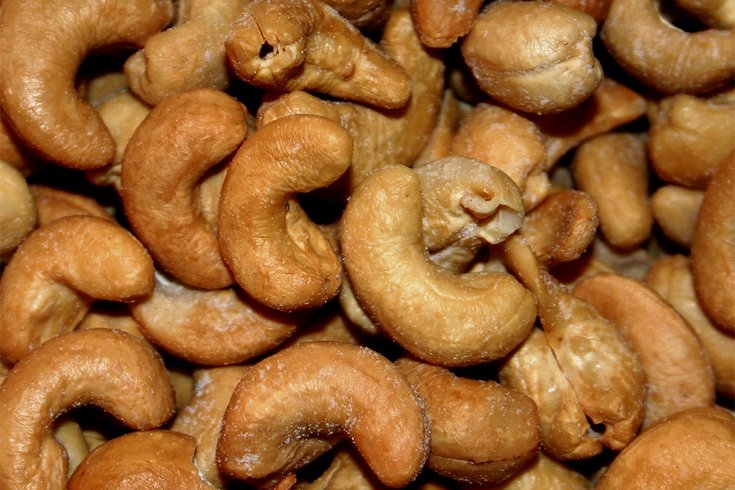
July 12, 2019
 Dave/via Flickr Creative Commons, CC by 2.0
Dave/via Flickr Creative Commons, CC by 2.0
Cashew nuts are high in FODMAPS, or fermentable oligosaccharides, disaccharides, monosaccharides and polyols), which are short-chain carbohydrates that wreak havoc in the small intestine of those with IBS.
I’m sure you’ve heard friends or family complain about “tummy troubles” at some point in your life.
Whether it’s bloating, abdominal pain or something more scandalous like diarrhea/constipation, someone you know has been there (maybe even you!). Unfortunately for a lot of people, these “tummy troubles” happen daily and can be diagnosed as irritable bowel syndrome, or IBS.
IBS affects anywhere from 7 percent to 15 percent of the population worldwide. It’s more prevalent in women than men, and is typically diagnosed before 50 years of age. The exact cause is unknown but many researchers believe it could be related to gastrointestinal motility, visceral hypersensitivity, inflammation and/or alterations in the gut microbiome. The main symptoms are bloating, abdominal distention, altered bowel habits (i.e. diarrhea, constipation or a mix of both), excessive gas and/or abdominal pain. IBS is always diagnosed by a gastroenterologist, as more serious conditions – celiac disease, inflammatory bowel disease, endometriosis, for example – have to be ruled out first.
A few questions that typically come up when someone is first diagnosed with IBS is 1) can it be “cured” and 2) what medication can I take to manage it. Unfortunately, it cannot be cured and medications aren’t always great at managing it.
But diet can help when symptoms and greatly improve quality of life for those suffering from IBS. The diet proven to manage symptoms – as well as being the most well researched – is the Low FODMAP diet. Created at Monash University in Australia, it has truly been life-changing for IBS patients.
So what exactly is the Low FODMAP diet? First off, it stands for Fermentable Oligosaccharides, Disaccharides, Monosaccharides and Polyols. These are then broken down even further into fructans, galactoligosaccharides, lactose, fructose, sorbitol and mannitol.
In lay terms, FODMAPS are short-chain carbohydrates that basically wreak havoc in the small intestine of those who have IBS. These small carbohydrates are poorly absorbed (or not absorbed at all) and pull water into the small intestine and are then fermented by bacteria in the colon. This stretches the intestine and stimulates the nerves in the gut, causing all those horrible symptoms mentioned above.
FODMAPS can be found in foods like wheat, garlic/onion, cashews, beans/legumes, asparagus, dairy, plums/peaches and sugar alcohols. I know this seems like A LOT and it is! Luckily the amazing researchers at Monash have tested hundreds of carbohydrates to figure out which foods are high and low in FODMAPs and in which amounts. Because that’s the other big thing with FODMAPs – you might be able to handle small amounts of say garlic, but if you eat it in large amounts then that’s when your symptoms will occur.
Dark chocolate is low in FODMAPS.
The Low FODMAP diet is done in three phases: the elimination phase, the reintroduction phase and finally the personalization phase.
The elimination diet can last anywhere from 2-6 weeks, although some people have found relief from their symptoms after only a few days! The reintroduction phase takes quite a bit longer as you re-challenge foods from each of the FODMAP groups and monitor for tolerance. The personalization phase is basically finding a balance between the FODMAPs that have been reintroduced into your diet and avoiding/limiting the high FODMAP foods that are not well-tolerated.
Studies have shown that patients doing a low FODMAP diet are more successful with the diet when working with a registered dietitian. Monash University also has an app (Monash University FODMAP Diet app) that is extremely helpful to anyone that needs to do the low FODMAP diet.
Liz McMahon, a Philadelphia-based registered dietitian nutritionist who works for a city hospital, writes a monthly column for PhillyVoice with a focus on gut health. She offers virtual nutrition counseling at her website, www.lizmcmahonnutrition.com.
She has completed and passed the Monash University Online FODMAP Course.
 Marco Verch Professional Photographer and Speaker/via Flickr Creative Commons, CC by 2.0
Marco Verch Professional Photographer and Speaker/via Flickr Creative Commons, CC by 2.0